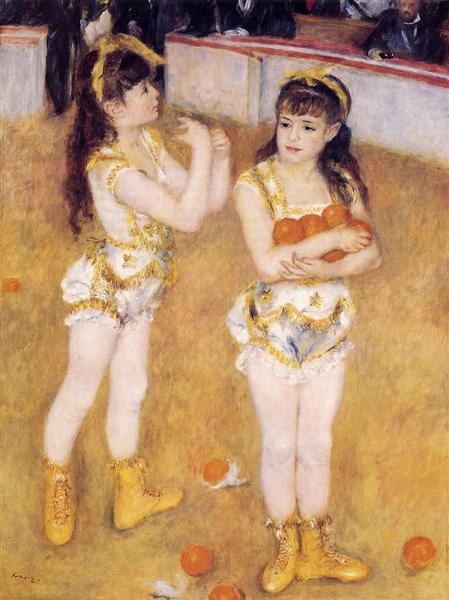Description
The work "Acrobats at the Circus Fernando" (Francisca and Angelina Wartenberg), painted by Pierre-Auguste Renoir in 1879, is a magnificent example of the artist's approach to everyday life and popular culture of the time. Set against the backdrop of the circus, a place full of spectacle and wonder, the painting captures the essence of family entertainment at the end of the 19th century, in a style that combines the vibrant and the intimate.
Renoir, who had been associated with Impressionism, uses in this work a rich and warm palette that characterizes his style during this period. The skin tones of the acrobats, in particular, are treated with a delicacy that gives them a sense of humanity and emotional connection. The light that filters over the figures seems to endow them with an almost ethereal glow, evoking the warmth and dynamism of the circus. In this sense, the work momentarily departs from the use of pure color typical of Impressionism and delves into a more personal and emotional treatment.
The composition of the painting is remarkable. Renoir positions the two acrobats on a diagonal that runs across the painting, creating a sense of movement and energy. Francisca and Angelina Wartenberg, known in their time as virtuoso acrobats, are displayed in a posture that highlights both the grace and strength of their bodies. The artist displays her mastery in capturing the interaction between the two figures and the environment, establishing a visual as well as emotional dialogue between the acrobats and the viewer. Their expressions, although subtle, manifest a mix of concentration and joy, reflecting the duality of their life as artists in the spotlight.
The background of the painting also deserves special mention. A festive atmosphere is suggested, with an audience gathering together, but it is not detailed too much, allowing the main figures to become the main focus of the work. This technique is characteristic of Renoir's work, who preferred not to allow unnecessary distractions that might detract from the expression and emotion in the foreground.
The choice of the circus, a common subject in late 19th-century painting, resonates with Renoir’s interest in modern life and urban culture. The work also reflects the bohemian lifestyle of Paris, where entertainment and nightlife were intertwined with artistic production. The popularity of circuses during this time, as well as the fascination with acrobatic and variety acts, translate into a vibrant and dynamic depiction that captures the essence of its time.
In conclusion, "Acrobats at the Fernando Circus" is not just a portrait of two artists in action; it is a reflection on life, spectacle and the beauty of human skill, all immortalized by the hand of Pierre-Auguste Renoir. Through his treatment of color, light and composition, the work manages to transcend mere entertainment and becomes a celebration of life itself, an act of admiration towards those who dedicate their existence to captivating and marveling others.
KUADROS ©, a famous painting on your wall.
Hand-made oil painting reproductions, with the quality of professional artists and the distinctive seal of KUADROS ©.
Painting reproduction service with satisfaction guarantee. If you are not completely satisfied with the replica of your painting, we will refund 100% of your money.

